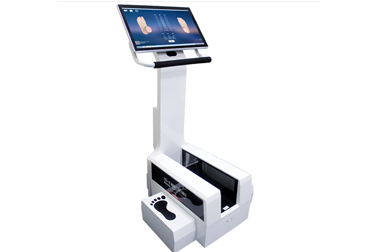The 3D foot arch scanner is a device used to accurately measure the foot shape, arch height and plantar pressure distribution. It is widely used in medicine, sports, rehabilitation, and orthopedic insole customization. Its core principle is based on 3D scanning technology. It provides high-precision foot data analysis through digital measurement, helps evaluate foot health, and optimizes footwear or correction solutions.
- The core principle of 3D scanning technology
The 3D foot arch scanner mainly uses the following scanning technologies to accurately capture the foot shape:
Laser scanning: Use laser to project onto the sole of the foot, calculate the foot surface shape through the displacement change of reflected light, and obtain accurate 3D data.
Structured light scanning: By projecting specific gratings or stripes onto the surface of the foot, the camera captures the deformation of light and reconstructs the 3D model through algorithms.
Infrared scanning: Use infrared sensors to detect foot shape, which is suitable for high-precision static measurement.
Optical + depth camera: Combine RGB cameras and depth sensors to achieve contactless, high-speed, and accurate 3D modeling.
The scanner is usually combined with a high-precision camera to reconstruct a complete 3D model of the foot through multi-angle shooting and computer vision algorithms.

- Main application functions
The application of 3D foot arch scanner mainly revolves around the following aspects:
Arch height detection: Accurately measure the height and angle of the arch, and analyze whether there is flat foot or high arch.
Foot morphology analysis: Obtain parameters such as foot length, foot width, toe shape, instep height, etc., to provide accurate data for shoe customization.
Plane pressure distribution evaluation (combined with pressure plate): Some scanners can be combined with plantar pressure sensors to analyze gait, center of gravity distribution, and optimize walking posture.
Orthopedic insole customization: Based on the scan data, generate a 3D model of personalized corrective insoles, and combine 3D printing or CNC engraving to make insoles.
Gait analysis and sports optimization: Provide athletes with plantar force distribution and gait stability analysis, optimize footwear selection and sports performance.
- Data acquisition and processing
The data collected by the scanner is processed by computer software, and the main process is as follows:
Data acquisition: The scanner obtains three-dimensional point cloud data of the foot to form a complete foot model.
Data cleaning and optimization: remove noise, optimize the surface, and ensure modeling accuracy.
Parameter analysis: The software automatically measures data such as arch height, plantar pressure distribution, and foot shape characteristics.
Result output and application: Generate reports for doctors, athletes, or shoe customization personnel to develop personalized orthopedic or gait optimization plans.
- Future development direction
AI intelligent analysis: Combine artificial intelligence to predict foot health risks and recommend correction plans.
Mobile portability: Develop scanning equipment compatible with mobile phones to improve portability and user experience.
3D printed insoles: Based on scanning data, directly 3D print personalized corrective insoles or orthopedic shoes.
Gait dynamic analysis: Combine high frame rate scanning technology to achieve real-time gait data collection and analysis.
The three-dimensional foot arch scanner uses high-precision scanning technology to achieve fast and accurate foot data measurement, providing a scientific basis for foot health management. It is not only suitable for medical rehabilitation and sports science, but also plays an important role in shoe customization, orthopedic treatment, etc., promoting the foot health industry to develop in an intelligent and personalized direction.
